Religious Beliefs of Rome
Published on: 27-Jun-2024Religious Beliefs of Rome
Belief System:Polytheistic; blending local; Greek; and foreign deities.Evolution:Started with animistic spirits (numina); later anthropomorphized under Greek influence.Political Link:Religion intertwined with politics; emperors used divine status for legitimacy.Major Gods:Jupiter (supreme god); Juno (women’s protector); Mars (war); Venus (love); Minerva (wisdom); Apollo (prophecy).Temples:Served as homes for gods; worship occurred outside.Rituals:Focused on precise ceremonies; personal belief was secondary.Afterlife:Early beliefs influenced by Greek myths (Hades; Tartarus); mystery cults and Christianity introduced heaven and hell concepts.Social Impact:Religion supported materialistic lifestyles; elites manipulated beliefs for control.Shortcomings:Gods seen as dependent and morally flawed.Roman religion, also known as Roman mythology was polytheistic from the beginning and was composed of the self-made beliefs and practices of the natives of the Italian peninsula from ancient times till the ascendancy of Christianity in the 4th century A.D.
Initially, the Romans worshipped an array of local gods and spirits but later on they added a number of Greek gods and a number of foreign cults to their religion. Some people believe that the Romans did not impose their beliefs on the regions they conquered, but historical accounts suggest countless persecutions of the Jewish and Christian population which resided in Rome or its controlled territories. However, as time passed, Christianity spread all over Rome and all of their gods were washed away and replaced by Christian beliefs. Some people believe that this was the change that brought the decline of the western empire.
Religion was the process of appeasing and honoring the gods in order to ensure that life proceeded as smoothly as possible. Gods were not honored to ensure an afterlife or a source of morality or holiness. In the pre-Christian Roman period, there was no word for religion: the word religio meant reverence. 1
The Romans, according to the orator and politician Cicero, excelled all other people in the unique wisdom that made them realize that everything was subordinate to the rule and direction of the gods. Yet Roman religion was based not on divine grace but instead on mutual trust between god and man which was in the control of their priests who could amend it as per their wishes. The object of Roman religion was to secure the cooperation, benevolence, and peace of the gods. The Romans believed that this divine help would make it possible for them to master the unknown forces around them that inspired awe and anxiety (religio), and thus they would be able to live successfully. Consequently, there arose a body of rules, the jus divinum (divine law), ordaining what had to be done or avoided. 2
Religion was one of the guiding forces of the life and sociopolitical systems of Rome. Although old and established, Roman religion was ever altered, influenced and then ultimately destroyed by the foreign gods and cults brought into Rome by the conquering legions and by the emperors. The Italians, and later the Romans, sprang from the same agrarian background as the Greeks, and perceived that nature was controlled by powerful natural forces.
Early forms of the Roman religion were animistic in nature, believing that spirits inhabited everything around them, including the people. The first citizens of Rome also believed that they were watched over by the spirits of their ancestors. Initially, a Capitoline Triad (possibly derived from a Sabine influence) were added to these spirits - the new gods included Mars, the god of war and supposed father of Romulus and Remus (founders of Rome); Quirinus, the deified Romulus who watched over the people of Rome; and lastly, Jupiter, the supreme god. They, along with the spirits, were worshipped at a temple on Capitoline Hill. Later, due to the Etruscans, the triad changed to include Jupiter who remained the supreme god; Juno, his wife and sister; and Minerva, Jupiter’s daughter.
Due to the presence of Greek colonies on the Lower Peninsula, the Romans adopted many of the Greek gods as their own. Religion and myth became one. Under this Greek influence, the Roman gods became more anthropomorphic – with the human characteristics of jealousy, love, hate, etc. However, this transformation was not to the degree that existed in Greek mythology. In Rome, individual expression of belief was unimportant, rather strict adherence to a rigid set of rituals was far more significant, thereby avoiding the hazards of religious zeal. Cities adopted their own patron deities and performed their own rituals. Temples honoring the gods were built throughout the empire; however, these temples were considered the home of the god and worship occurred outside them. While this fusion of Roman and Greek deities influenced Rome in many ways, their religion still remained practical. 3
The accepted idea of adding gods to the cults of Rome had the most profound consequences on the development of Roman religion. The Greeks arrived in Rome probably before the end of the monarchy. Shrines by Tarquinius to Jupiter, Juno and Minerva elevated these three to the level of supreme rulers of the Roman pantheon. Other Grecian imports included Apollo, Cybele and Asclepius (Aesculapius). Total victory for the Greeks came only after the Punic Wars, when the Romans, now masters of the Mediterranean world, adopted wholesale Greek identities for their gods. Old, titanic forces of nature were replaced by new, more human deities, in an ironic replaying of Greece's own theological history. Zeus was Jupiter, Hera was Juno, Athena was Minerva, and Poseidon was Neptune and so on. Early in Roman religious history a tendency developed to link political power with religion. The kings of Rome probably began this idea, acting as heads of the priesthoods of Rome while retaining their monarchical status. In the Republic this system was unchanged, placing, as it did, broad authority in the hands of the Patrician class. It shows that religion was a mere tool used for personal gain and power for the elite class of ancient Romans who ensured their superiority by linking their political position with religion, and nobody could dare question its authority because the naïve people believed that if they offended their king or ruler, they would also offend their god.
Magistrates formed the priestly colleges, performed the ceremonies of worship and responded to the decrees of the Senate, which decided most questions of a religious or doctrinal nature. But there was no centralization or institutionalization of the cult of state, a situation made worse by the rise of the Plebeians. Thus, while the sacred rites were performed right up until the end of the Republic, they had lost much of their meaning. 4
From the earliest days, religion played a key role in family life and in the larger community. Roman religion was focused on daily life in the present, not a future afterlife in a perfect heaven. The Romans believed that everything in nature had a spirit associated with it, and so did human-made items and activities. For example, a house or even a doorway had a spirit associated with it. So did such important activities as planting and harvesting crops. 5
The state religion grew from the rituals of early farming families who asked the numina (natural spirits) to give them healthy children, favorable weather, good harvests, and protect them from enemies. As the farming community expanded priests began to organize these requests on behalf of all the people. In time, the early Romans adopted the more sophisticated Greek gods, built temples to them, and so the state religion emerged. 6
The gods also included real Romans who were deified, made into gods. Julius Caesar, Augustus and several other emperors were worshipped as gods after their deaths. In some parts of the eastern empire, people worshipped the emperors as gods while they were still alive. The Roman government did not try to stop it, because the practice helped strengthen loyalty to the empire in distant regions. In general, the Romans let conquered people worship any way they chose, as long as they did not deny the role of the official state religion and the accepted gods 7 which shows that they were such primitive people that they were not aware of their purpose of life and the reality of their creator.
The Romans had no sacred writings other than the formulae of prayers, and so they were not bound by dogma. They were free to think and believe what they wanted about their gods, provided that rituals were performed correctly. The gods, though, were regarded as being in favor of many of the principles of Roman life, such as patriotism, family devotion and a sense of duty, and they were closely associated with these virtues. 8
Concept of God
The Romans, like the Melanesians (and Polynesians) of modern times, believed in a supernatural power or influence which they called Numen, plural Numina. 9 The word numen is a neuter word meaning 'nodding'. Its use was connected with the idea that fertility resides in the head: the concept was anthropomorphic but not in its entirety. Gradually the numina were transformed into the fully anthropomorphic god, male or female, and sometimes with uncertain sex. The function, which was once the whole god in embryo, then became an attribute, and the new god gradually attracted a variety of attributes represented by cult-titles. 10
The early Romans looked upon their gods as beings who were able to bring good or evil to them. They did not have the strong personality of the Greek gods, but they stood in a quite definite relation to man and the Roman believed that there were duties and obligations to be fulfilled on both sides. Religion was looked upon as a contract; if a god answered the prayer of man, then man was obligated to make a thank-offering; but on the other hand, if man had done his duty, the god must make his return in gifts of prosperity and well-being. 11 The Romans had this misconception because they believed that they were equal to God and hence the give and take ritual was also based on equality. It’s a wonder that the people who couldn’t even figure out tiny things were actually considered to be one of the greatest civilizations of the world and eligible to be followed.
Through the influence of the Greeks and Etruscans, the Romans began to give their spirits human traits. The most important Roman gods became associated with similar Greek gods. The Roman god Jupiter, for example, who ruled everything above Earth, was just like the most powerful Greek god, Zeus. Venus, the goddess of love, associated with the Greek goddess Aphrodite. A few gods had the same name in both the Greek and Roman religions. The most important of these was Apollo, the god of the sun, who ruled over poetry, music, and medicine.
There were also goddesses (female gods). Juno, Jupiter’s wife, was said to protect women. Minerva was the goddess of wisdom. The roles each specific god played in people’s lives sometimes changed over time. In the early days, the most important gods were associated with agriculture, since farming was crucial to daily life. Both Jupiter and Mars started out this way. Jupiter provided the rain and light that made crops grow, while Mars watched over Roman crops and field animals.
Eventually Jupiter was seen as god of specific cities, including Rome itself, and the god who ensured Rome’s triumphs in war. Mars also became associated with war, sharing the traits of the Greek war god, Ares. A god or goddess sometimes had several roles and several names. Diana (originally an ancient Italian goddess of the forest) became the goddess of fertility (the ability to have babies), of virgin girls, and the moon. She was also known as Luna, the Latin word for moon, and Juno Lucina. When praying to a god, the Romans often said, ‘Hallowed be thy name, whatever name it is that you prefer’. By this, if they forgot one of the names, they would not offend the god. 12
The Pantheon
The major Roman gods were often thought of in groups, the best known being the Olympians (Juno, Jupiter, Apollo, Minerva, Ceres, Diana, Bacchus, Mars, Vulcan, Venus, Neptune and Mercury), who paralleled the Greek Olympian gods. Di consentes were the 12 great gods (six gods and six goddesses). 13 Their description is as follows:
Juno
Juno was one of the most important goddesses of the ancient Romans. She was enshrined, together with Jupiter and Minerva, in the ancient temple on the Capitoline Hill in Rome (She was one of the major goddesses of the city). Juno's special sphere was the life of women, particularly childbirth. As a protector in childbirth she was worshipped as Juno Lucina, ‘Juno who brings to light.’ She was also worshiped in other forms, such as Juno Sospita, ‘Juno the Deliverer or Preserver,’ Juno Moneta, ‘Juno who warns,’ and Juno Regina, ‘Queen Juno.’ Juno was most often represented as a mature but young woman.
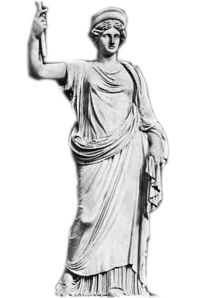
As Juno the Deliverer she was shown bearing arms. The story of how she protected the Capitol in 390 B.C. may have given her the name Juno Moneta. The Gauls were trying a sneak attack under the cover of night. The honking of Juno's geese gave them away. Eventually the Romans identified Juno with the Greek goddess Hera. English month of June takes its name from her.
Jupiter
By degrees, the god Jupiter took the place of Janus as the supreme god of the state. Jupiter was the Father of gods and the Lord of Justice, and as time went on, he grew to symbolize the majesty and greatness of Rome. In his temple on the Capitol sacrifices were offered by all youths as they approached manhood, by magistrates about to take office, by victorious generals returning from war with their spoils, and on the walls were hung all treaties made by Rome with other nations. 14
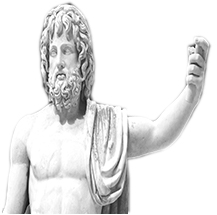
The name Jupiter is related to the Greek name Zeus and the Sanskrit name Dyaus Piter. This relationship connects Jupiter with an ancient sky god worshiped as father. When the Romans encountered Greek culture, they identified Jupiter with Zeus. The Romans called this Jupiter ‘Optimus Maximus’—‘Best and Greatest.’ The Romans worshiped Jupiter under many other names, too. They include Jupiter Lucetius (Bringer of Light), Tonans (Thunderer), Fulgur (Lightning Hurler), Elicius (Giver of Heavenly Signs), and Latiaris (God of the Latins). Like other sky gods, Jupiter watched over treaties and oaths. His priests presided over the most solemn form of Roman marriage. 15
Apollo
He was the god of healing, oracles and prophecy, music and poetry. He was introduced to Romans through contacts with the Etruscans, north of Rome, and the Greek settlements of southern Italy. His chief symbol was the laurel tree. The emperor Augustus, who adopted Apollo as his patron deity, held that the god had helped ensure the Roman victory at Actium in 31 B.C. and showed his gratitude by erecting a small but impressive temple to him on the Palatine hill. 16
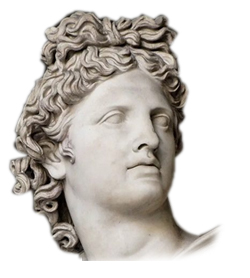
Minerva
She was known to the Greeks as Athena, an important Roman divinity, ranking behind Jupiter and Juno. According to legend, Minerva was born fully formed and armed, coming out of Jupiter's head as an emanation of his intellect. The Romans thus honored her as a goddess of reason, wisdom, the arts and intelligence. She received a special chapel in the Temple of Jupiter Capitolinus on the Capitoline Hill, sharing the great edifice with Jupiter and Juno. As her appearance indicated, with her bright helmet, shield, armor and spear, Minerva was the patroness of soldiers in battle, watching over men's courage, skill and fortitude. Captured goods or treasures from the enemy were often sacrificed in her temple on the Capitol, or at her altar at the base of the Caelian Hill. The Festival of Quinquatrus, or Quinquatria, was at first wholly unrelated to Minerva, but became attached to her cult over the years. 17

Ceres
Ceres, in Roman religion, was the goddess of the growth of food plants. She was worshiped either alone or in association with the earth goddess Tellus. At an early date her cult was overlaid by that of Demeter, who was widely worshiped in Sicily and Magna Graecia. On the advice of the Sibylline Books, a cult of Ceres, Liber, and Libera was introduced into Rome (according to tradition, in 496 B.C.) to curb a famine. The temple, built on the Aventine Hill in 493 B.C., became a center of plebeian religious and political activities and also became known for the splendor of its works of art. After being destroyed by a fire in 31 B.C., it was restored back in to its glory by Augustus. 18
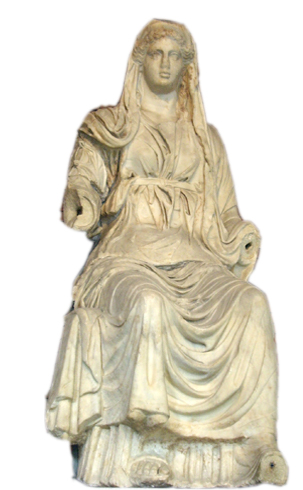
Diana
Diana was originally identified as the goddess of the forests and wild nature, but after associating with the Greek deity Artemis, she took on her image as a goddess of hunting, the moon and the protector of women. The Hymn to Diana, by the poet Catullus, effectively describes her various roles. She was known as the virgin goddess of childbirth and ladies, and was also one of the three goddesses, alongside Minerva and Vesta, who swore never to wed. Oak forests and deer were particularly holy to her. Diana made up a triad with two other Roman gods; Egeria the water sprite, her hireling and associate maternity specialist; and Virbius, the forest god. 19 An early temple to Diana was raised on Rome's Aventine hill; her festival was held on August 13. 20
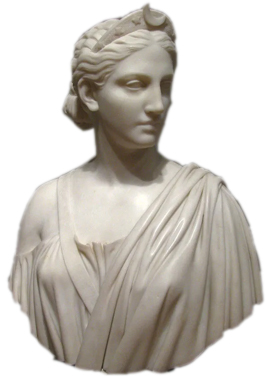
Bacchus
Bacchus was the Roman characterization of the Greek Dionysus, a deity who represented the power of intoxication and ecstasy (literally being outside the self). He was known as the Liberator, freeing individuals from their day-to-day lives through drunkenness, madness, or artistic expression. Paradoxically, he was also viewed as the promoter of civilization, a lawgiver, and lover of peace—as well as the patron deity of agriculture and the theatre. The divine mission of Bacchus was to bring an end to care and worry.

He was thought to represent the union between the realms of the living and the dead (as per the two mythic stories of his death and rebirth). This chthonic role was especially pronounced in Roman religion, which spurred on the development of the Bacchanalia—a rebirth/renewal festival with a basis in the Greek mystery religions. 21
Bacchus was ordinarily represented under the naked figure of a beautiful young man, but considerably plump in his face and limbs, as might seem best to befit the generous living of the patron of the vine, and his countenance expressed the merry and jovial casts of thought which wine inspires. He was crowned with ivy and vine-leaves, and bore in his hand the thyrsus, a dart twined round the leaves of ivy and vine. 22
Mars
Originally an Italian god of agriculture, Mars protected farmers' fields and boundaries. But in time he came to be identified with Ares, the Greek god of war, and as Mars Ultor (Mars the Avenger), although he continued to oversee agriculture as Mars the Father. The Romans came to see him as second in importance only to Jupiter. March, originally the first month in the Roman year (because it witnessed the annual rebirth of agriculture), was named after him (as was the great parade ground in Rome, the Campus Martius, or ‘Field of Mars’). Several religious festivals to honor him were held in that month, including one that began on March 1 and lasted for over three weeks, featuring parades, dancing, hymn singing, and feasts; the Equirria, held on March 14, which featured horse races in the Campus Martius; and the Greater Quinquatrus, from March 19 to 23, on the last day of which Rome's sacred war trumpets (tubae) were purified. Mars's most important altar stood, appropriately, in the Campus Martius, and he had numerous temples, including one erected by Augustus in the main /Forum and one on the Appian Way outside the city.
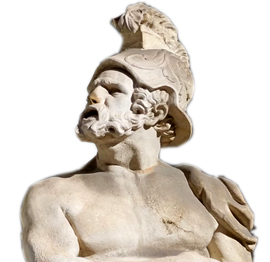
Vulcan
Vulcan (or Vulcanus) was the god of fire, he became identified with the Greek Hephaestus, god of the forge. In the capacity of a smelter of metals, he was called Vulcan Mulciber, and he was often seen as a more destructive counterpart of Vesta, who represented a more positive force of fire. Vulcan was often pictured living and working beneath volcanoes, assisted by giants called Cyclopes. His most famous shrines were in Rome's main Forum, at the base of the Capitoline hill, and at the port city of Ostia. His festivals were held on May 23 and August 23. 23
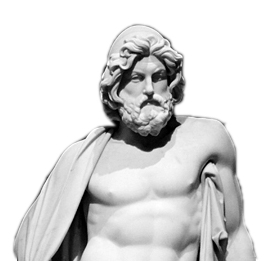
Venus
Venus was a major Roman goddess principally associated with love, beauty and fertility, as well as plough lands and gardens. Venus carried on a tradition of eroticized female divinities featured in the legends of surrounding Indo-European and Near Eastern mythological systems, such as Inanna of the Sumerians, Ishtar of the Mesopotamians, Hathor in Ancient Egypt, Astarte of the Syro-Palestinians, Turan among the Etruscans, and the Ushas, Vedic goddesses of the dawn. Like the Greek goddess Aphrodite, Venus is described as a beautiful female with jurisdiction over love, sexuality, fertility, and sometimes even prostitution which is called as sacred prostitution to satisfy their devilish desires under the umbrella of religion. It is likely that Venus, borrowed significant aspects from the attributes of surrounding goddesses and even distant Indo-European celestial cousins. 24
Neptune
Neptune or the Greek god Poseidon, 25 Latin Neptunus, in Roman religion, originally the god of fresh water; by 399 B.C. he was identified with the Greek Poseidon and thus became a deity of the sea. His female counterpart, Salacia, was perhaps originally a goddess of leaping spring-water, subsequently equated with the Greek Amphitrite. 26
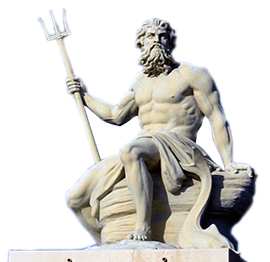
Mercury
In Rome, the Greek god Hermes was known as Mercury. He was the messenger god who carried out the orders of Jupiter. Known for his swiftness, both the Greeks and Romans portrayed him as a handsome youth with winged shoes and hat. In his hand, he carried a winged staff entwined with snakes (called a kerykeion in Greek and caduceus in Latin) that protected him as he travelled. He also served as the mediator between gods and mortals and between the living and the dead.
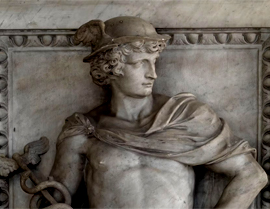
As the protector of travelers, Hermes was believed to keep roads free of stones and to mark out routes for travelers to follow. In his honor, people erected monuments called herms along roads. The earliest herms were little more than piles of stones around a pillar, but later they became more elaborate and were placed in city streets and courtyards as well as along country roads. 27
Emperor gods
With the expansion of the empire, Rome came to rule eastern nations that were accustomed to worshipping their kings as gods and that readily transferred their worship to Roman rulers. Augustus and his successor Tiberius thought that this practice of worshipping living rulers as gods would be provocative if transferred to the west, but since the practice could not be eradicated in the east, they instead encouraged the worship of Roma, the divine spirit of Rome. Augustus tried to defuse future unrest by encouraging the worship of the genius or numen (spiritual power embodied in the emperor) and not the living emperor. In the west the cult of Augustus grew, often associated with Roma. Evidence from inscriptions shows how various virtues were personified and worshipped, including Virtue, Victory, Discipline and Fortune. For example, several altars were dedicated to Fortuna Augusta (the fortune or luck of the emperor), the focus of this cult being at Lyon. Temples were also dedicated to Fortuna Augusta, as at Pompeii.
After his death in 44 B.C. Julius Caesar was regarded as having joined the ranks of the gods (that is, to have been deified), and after Augustus, who died in 14 A.D., it was common for an emperor to be deified after his death. In the west deified emperors were closely associated with the cult of Roma, but in the east worship of living emperors continued. The worship of the emperor became a test of loyalty to Rome—subjects were free to worship whatever gods they chose, provided they paid homage to the emperor. There is evidence from fragments of calendars from the Augustan period that festivals or celebrations devoted to the emperor or his family took place about twice a month. 28
Other gods
The Greeks were not the only people who influenced Roman religion. As the empire spread to Egypt and Asia Minor, the Romans adopted some gods from those regions. One of the earliest foreign gods accepted in Rome was Cybele. This goddess from Asia Minor was associated with nature and was sometimes called the Great Mother. While battling Carthage in 205 B.C., Roman officials tried to win her favor. Rituals devoted to her and her husband, Attis, featured wild outdoor dancing and priests cutting their own bodies.
In some cases, foreign gods were associated with existing Roman gods. For example, Sulis, a Celtic god worshiped in Britain, was associated with Minerva. The Syrian god Baal was linked to Jupiter. Other times, the new gods were given their own position of importance in the state religion. Some of the new gods were worshipped in what were called mystery cults because believers did not talk about the details of their faith and its ceremonies. They took part in these cults while still practicing the state religion. The mystery cults offered a more direct experience with a god’s spiritual power, and some of the cults promised eternal life.
The mystery cult of the goddess Isis came from Egypt. Starting in the first century B.C., Rome tried to ban it. But people continued to worship Isis, and the emperor Caligula added her to the state religion. Another cult centered on the Parthian god Mithras. He was associated with the sun, and his followers believed they would live forever. 29 Though everybody knew that no mortal could live forever. ]
Other Cults
Besides the worship of these gods there were several cults, which were imperial in nature. Some were readily accepted by Roman society while others were feared by those in power. A cult was centered on Cybele, the ‘great mother’ - a fertility goddess with a temple on Palatine Hill who was responsible for every aspect of a person’s well-being. The goddess arrived in Athens in the 5th century B.C. and first appeared in Rome during the Punic Wars. All of her priests were eunuchs, and many of her male followers would have themselves castrated.
Next was Isis, the ancient goddess of Egypt that is best remembered in Egyptian mythology as the wife of Osiris and the mother of Horus. After becoming Hellenized, she became the protector of sailors and fishermen. Arriving in Rome from Alexandria, Sarpis was a healing god and the sick would travel to her temple to be cured. Sibyl was a priestess of the Greek and Roman god Apollo who came to Rome from the Greek colony of Cumae. She offered the Etruscan King Tarquin the nine Sibylline Books which were books of prophecy, but the price was considered too high, so he refused. After she had burned six of the books, he reconsidered and bought the remaining three; these three books were consulted by the Roman Senate in times of emergencies but they were lost during the barbarian invasions of the 5th century C.E. 30
Judaism
The Jewish people were centered in Judaea and had practiced their religion for centuries before the rise of Rome. In 64 B.C., the Jews in Judaea came under the Roman influence. Some Jews eventually settled in Rome and other parts of the empire. Unlike the Greeks, Romans, and other Mediterranean peoples, Jews worshipped just one god. They had strict rules about how to worship that god and live their daily lives. Those rules included rejecting all the Roman gods.
At first, Roman officials let the Jews practice their faith without forcing them to accept the Roman gods. Gradually, however, some Romans distrusted the Jews because they did not also practice the state religion. Tiberius cracked down on the practice of Judaism in Rome. According to Suetonius, in The Twelve Caesars, Tiberius ordered all Jews ‘to burn their religious
In Judaea, the Jews rebelled against Roman rule several times. They were fighting for their political independence and religious freedom. During the first revolt, from 66 to 70 A.D., the Romans destroyed the Jewish temple in Jerusalem. Starting around 129 A.D., Hadrian announced new limits on the practice of Judaism. He also planned to build a Roman style city where Jerusalem stood. Those actions led to a second revolt in 132 A.D., which also ended with a Roman victory. 32
Mithraism
The cult and mysteries of Mithra were the most widespread of these, apparently first taken up by soldiers of Pompey from Cilician pirates. The cult was obviously derived from the older Iranian cult, but from the two intervening centuries that separate these cults little is known about Mithra; the cult spread, however, to all areas of the empire. It involved initiation in a simulated cave; immortality was promised to initiates as a reward for the soldierly qualities of courage and discipline. 33
It found followers in the ranks of the army and among the social elite. Oriental faiths soon spread throughout the Eastern Empire, with Serapis, Elagabalus and even Osiris offering choices to the soul-searching Romans. Two interesting trends evolved toward the end of the 2nd century A.D.: syncretism and monotheism. Syncretism, the mixing together of one or more deities into a single form, was used in the Mithraic cult, as the god was sometimes equated with Sol Invictus. The effect of all this was that Roman mythology was reduced into a debased and mystical mode of worship. Monotheism, born perhaps out of Mithraic-Solar belief and Christianity, was a partial return to the prime deity of the cult of state. Sol, sometimes known as Elagabalus in the early 3rd century, was respected by the Flavians and placed at the heart of the Roman religion of state by Aurelian. All that Sol Invictus succeeded in doing, however, was to prepare the Roman Empire psychologically for the far more enduring god of Christianity.
The eastern cult, which came to conquer the entire Empire, was one of the few creeds actively persecuted by Rome. After Judaism effectively separated itself from Christianity, Christians came under attack because of the realization that belief in Jesus Christ was exclusive. One could not attend Christian services as well as offer sacrifices to Jupiter. An eternal enmity erupted between Christianity and what came to be known as organized paganism. 34
Christianity
During the first century, a new religion emerged in the east with its roots in Judaism. Around 29 A.D., Roman officials in Judaea ordered the crucifixion of a Jew known as Jesus. 35 was a prophet of Allah and was neither a Jew and nor was crucified by the Jewish authorities. He was lifted to the heaven by Allah Almighty and will return before the Day of Judgment to kill the Anti-Christ. His teachings were not Jewish and were simply the teachings of Islam which was preached by the prophets before him. A thorough detail with all the references can be seen in Vol. 1 of Seerat Encyclopedia in the Chapter of Christianity.] Before his death, Jesus  had preached a philosophy of love and the promise of life after death. Jesus was a follower of monotheism like the Jews, but some of his teachings did not follow the widely accepted Jewish beliefs. This angered some of the Jewish leaders in Judaea.
had preached a philosophy of love and the promise of life after death. Jesus was a follower of monotheism like the Jews, but some of his teachings did not follow the widely accepted Jewish beliefs. This angered some of the Jewish leaders in Judaea.
After Jesus’ death (as per the Christian belief), his closest followers said that Jesus rose from his grave and went to heaven. The Christians believed this was a sign that he was the son of God. Based on the writings of his followers, a new faith emerged: Christianity. In Greek, which was the most common language in the eastern half of the Roman Empire, Jesus was called Christos, or ‘anointed one.’ In English, this became Jesus Christ. Greek-speaking Jews and non- Jews who also believed that Jesus was the son of God began spreading the self-forged Christianity throughout the Roman Empire. Paul, one of the most important early Christians, the twister of the facts and a Roman citizen, made four journeys to try to convert Romans to this new faith. The Roman emperors, however, disliked the Christians and their ideas.
Even more than the Jews, the Christians actively tried to recruit new members. The Christians also seemed to threaten public order, because they said all people were equal in God’s eyes. This message appealed to the empire’s poor and went against the Roman idea of aristocracy, which said some people were better than others. The emperors did not want large groups of people meeting and discussing ideas that might challenge the position of the rich and powerful in Rome. 36
Roman authorities viewed Christians with suspicion, concerned about their potential to create social unrest. Although some early Christians were killed for their beliefs, widespread persecutions occurred infrequently. This situation changed during the early and mid-A.D. 200s, when the emperors Decius and Valerian persecuted Christians for their refusal to worship the pagan Roman gods. Then in A.D. 303, the emperors Diocletian and Galerius issued a series of edicts that marked the beginning of a period known as the Great Persecution. These edicts ordered the destruction of churches and the burning of sacred books. All clergymen who did not cooperate were arrested, and all Christians were removed from public service and from the army. A final edict ordered all Christians to make sacrifices to the pagan gods or face execution— an order that was enforced in all the eastern provinces and in Africa, although not elsewhere in the western empire.
This oppression ended in A.D. 313, when the emperor Constantine I issued an edict promising toleration for all religions, including Christianity. He later granted Christians various privileges and strengthened the authority of church leaders. His actions marked the first steps in making Christianity the official religion of the Roman Empire. Constantine also founded the city of Constantinople in 324 A.D., and made it the new capital of his empire. In contrast to Rome, with its numerous pagan temples, Constantinople was planned as a great Christian city. 37
Later on, in the late 4th century, Theodosius I, in a series of edicts, banned all non-Christian rites and many Christian ones that were considered heretical, and Christianity became the official state religion. 38
Arianism
A widely popular Christian sect that arose in the early third century, mainstream bishops viewed it as a threat to the church and it became known as the Arian heresy, after Arius, a priest of Alexandria, Egypt. Essentially, the Arians held that, though Jesus had existed since before time began, he had been created by God the Father and was therefore not fully divine.
The idea that Jesus was inferior to God provoked such heated debate among church leaders that Constantine himself had to intervene, calling a great council in 325 A.D. at Nicaea, which more than two hundred bishops attended. (This was the first of seven Ecumenical Councils held by the early church, the last also taking place in Nicaea in 787 A.D.) Constantine himself sided with the majority against the Arians. He appears to have suggested that the church adopt the concept of homoousios, ‘of the same substance,’ essentially meaning that Christ and God were one and the same.
With this imperial support, the anti-Arians prevailed and formulated a creed designed to clarify the proper way of viewing God and Christ; with a few later additions it became known as the Nicene Creed, the most universally accepted statement of Christian belief for many centuries to come. But though cursed by many, Arianism was far from dead. Constantine's son, Constantius II, was an Arian who encouraged the spread of Arian views. During his reign, Arian Christian missionaries converted many of the Goths, a Germanic tribe living mainly north of the Danube River; the result was that millions of Arian Christians did not embrace the Nicene version of Christianity until early medieval times. 39
Concept of After Life
The myths, philosophy, and religious views of the Greeks had a profound influence on early Roman ideas concerning the afterlife. Like the later Greeks, many Romans believed in the immortality, or everlasting life, of the soul. They also believed, to some extent, in the idea of reincarnation—the rebirth of the soul in a new body. 40
From about the 3rd century B.C. on, the Romans shared the same general ideas about the afterlife with the Greeks, whose views on the subject varied considerably, as is the case in most modern societies. Some people held that the soul continues to exist after death, while others thought that it floats away into the sky, as advocated by the Greek philosopher Plato in his treatise Phaedo. The Epicureans preached that the soul is made up of atoms, which dissipate and vanish after death, while the Stoics advanced no single, dogmatic belief about the soul's fate. There was also widespread disagreement over where the soul resides, if it does indeed survive after death; whether a dead person can perceive the living; and if the dead receive either rewards or punishments in the afterlife.
The most common traditional folk beliefs, derived originally from the epic poems of the Greek poet Homer, held that both good and bad souls descended into the underworld (Hades). There, according to one view, wrongdoers suffered various punishments in a ghastly place called Tartarus; while more virtuous people, particularly renowned heroes, lived on in abodes of eternal happiness. However, it is questionable whether such beliefs were still common in Rome's mid-to-late republican and imperial eras. Evidence shows that many people believed, for instance, that the soul lived on inside a dead person's grave marker or in the tomb itself; for this reason it was common practice to bring gifts to the tomb, pour sacrificial wine on it (or into it through pipes), and/or perform periodic celebrations at the gravesite to appease the dead. Also, in the apparent belief that the dead could rise up and haunt the living, some people decapitated the bodies or placed large stones over the coffins.
The mystery religions, including Christianity, were notable for advancing the notion of a happy afterlife (heaven, in the Christian version), which increasingly appealed to the confused, fearful, and downtrodden people. In the Later Empire, after Christianity's triumph, the Christian concepts of heaven and eventually hell (as advocated by Augustine and other Christian writers) became common across Europe. 41
The ancient Romans were interested in nothing else but fulfilling their desires in one way or the other. To the pagan Roman, the meaning of life was nothing more than a time period in which one should enjoy to the fullest because he did not believe in the concept of afterlife. Even the Christian Roman was no different, although he did believe in the hereafter, but due to the dominance of materialism over his heart, and the corruption done by the priests in the bible, he also became materialistic and desired nothing but worldly pleasure, regardless of the fact if it was right or wrong. Hence, in order to fulfill their desires, they designed a religion in which all the desires were fulfilled under its guise. When Jesus Christ came to this world, he also tried to guide them, but they were not willing to give up their luxurious and immoral lifestyle, hence they amended the divine religion after Jesus Christ was taken to the skies. Later on, even the political class took advantage of religion by deifying themselves so that they could rule without being questioned. All in all, the religion of ancient Rome was nothing more than a set of rules and mythical stories compiled to misguide the people so that the elite and the priestly class could fulfill their desires.
- 1 Lesley Adkins & Roy A. Adkins (2004), Handbook to Life in Ancient Rome, Facts on File Inc., New York, USA, Pg. 274.
- 2 Encyclopedia Britannica (Online Version): https://www.britannica.com/topic/Roman-religion: Retrieved: 15-12-2017
- 3 Ancient History Encyclopedia (Online Version): https://www.ancient.eu/Roman_Religion/: Retrieved: 15-12-2017
- 4 Mathew Bunson (1994), Encyclopedia of the Roman Empire, Facts on File Inc., New York, USA, Pg. 853.
- 5 Ibid, Pg. 109.
- 6 Norman Bancroft Hunt (2009), Living in Ancient Rome, Chelsea House, New York, USA, Pg. 76.
- 7 Michael Burgan (2009), Empire of Ancient Rome, Chelsea House Publishers, New York, USA, Pg. 111.
- 8 Lesley Adkins & Roy. A Adkins (2004), Handbook to Life in Ancient Rome, Facts on File Inc., New York, USA, Pg. 274.
- 9 H. J. Rose (1959), Religion in Greece and Rome, Harper & Brother Publishers, New York, USA, Pg. 161.
- 10 Geoffery Parrinder (1971), World Religions: From Ancient History to the Present, Facts on File Inc., New York, USA, Pg. 164-165.
- 11 Dorothy Mills (1937), The Book of the Ancient Romans, G. P. Putnam’s Sons, New York, USA, Pg. 123.
- 12 Michael Burgan (2009), Empire of Ancient Rome, Chelsea House Publishers, New York, USA, Pg. 110-111.
- 13 Lesley Adkins & Roy. A Adkins (2004), Handbook to Life in Ancient Rome, Facts on File Inc., New York, USA, Pg. 279.
- 14 Dorothy Mills (1937), The Book of the Ancient Romans, G. P. Putnam’s Sons, New York, USA, Pg. 129-130.
- 15 Robert S. Ellwood & Gregory D. Alles (1998), The Encyclopedia of World Religions, Facts on File Inc. New York, USA, Pg. 197-198.
- 16 Don Nardo (2002), The Green Haven Encyclopedia of Ancient Rome, Green Haven Press, California, USA, Pg. 102.
- 17 Mathew Bunson (1994), Encyclopedia of the Roman Empire, Facts on File Inc., New York, USA, Pg. 683.
- 18 Encyclopedia Britannica (Online Version): https://www.britannica.com/topic/Ceres-Roman-goddess Retrieved: 16-12-2017
- 19 Rose Williams (2009), The Clay-footed Superheroes: Mythology Tales for the New Millennium, Bolchazy-Carducci Publishers, Illinois, USA, Pg. 56.
- 20 Don Nardo (2002), The Green Haven Encyclopedia of Ancient Rome, Green Haven Press, California, USA, Pg. 107.
- 21 New World Encyclopedia (Online Version): http://www.newworldencyclopedia.org/entry/Bacchanalia Retrieved: 19-12-2017
- 22 Edward Baldwin (1814), The Pantheon or the Ancient History of the Gods of Greece and Rome, M’ Millan, London, U.K., Pg. 177.
- 23 Don Nardo (2002), The Green Haven Encyclopedia of Ancient Rome, Green Haven Press, California, USA, Pg. 115, 122.
- 24 New World Encyclopedia (Online Version): https://www.newworldencyclopedia.org/entry/Venus_(mythology) Retrieved: 19-12-2017
- 25 Luke Roman & Monica Roman (2010), Encyclopedia of Greek and Roman Mythology, Facts on File, New York, USA, Pg. 418.
- 26 Encyclopedia Britannica (Online Version): https://www.britannica.com/topic/Neptune-Roman-god 20-12-2017.
- 27 Carrol Moulton (1998), Ancient Greece and Rome: An Encyclopedia for Students, Charles Scribner’s Sons, New York, USA, Vol. 1, Pg. 141.
- 28 Lesley Adkins & Roy A. Adkins (2004), Handbook to Life in Ancient Rome, Facts on File Inc., New York, USA, Pg. 275-276.
- 29 Michael Burgan (2009), Empire of Ancient Rome, Chelsea House Publishers, New York, USA, Pg. 111-112.
- 30 Ancient History Encyclopedia (Online Version):https://www.ancient.eu/Roman_Religion/: Retrieved: 15-12-2017
- 31 The books of history state that the Jews who resided in the Islamic state of Madinah lived peacefully and practiced their religious rituals freely since Prophet Muhammad ﷺ had strictly forbidden to destroy the temples of any religious group.
- 32 Michael Burgan (2009), Empire of Ancient Rome, Chelsea House Publishers, New York, USA, Pg. 112-113.
- 33 Lindsay Jones (2005), Encyclopedia of Religion, Thomson Gale, Michigan, USA, Pg. 8840.
- 34 Mathew Bunson (1994), Encyclopedia of the Roman Empire, Facts on File Inc., New York, USA, Pg. 854.
- 35 According to the most authentic source i.e. the Holy Quran and other correct Biblical and historical sources, Jesus [symbol, en, 4
- 36 Michael Burgan (2009), Empire of Ancient Rome, Chelsea House Publishers, New York, USA, Pg. 113-114.
- 37 Carrol Moulton (1998), Ancient Greece and Rome: An Encyclopedia for Students, Charles Scribner’s Sons, New York, USA, Vol. 1, Pg. 123-124.
- 38 Lesley Adkins & Roy A. Adkins (2004), Handbook to Life in Ancient Rome, Facts on File Inc., New York, USA, Pg. 276.
- 39 Don Nardo (2002), The Green Haven Encyclopedia of Ancient Rome, Green Haven Press, California, USA, Pg. 102.
- 40 Carrol Moulton (1998), Ancient Greece and Rome: An Encyclopedia for Students, Charles Scribner’s Sons, New York, USA, Vol. 1, Pg. 11.
- 41 Don Nardo (2002), The Green Haven Encyclopedia of Ancient Rome, Green Haven Press, California, USA, Pg. 101-102.